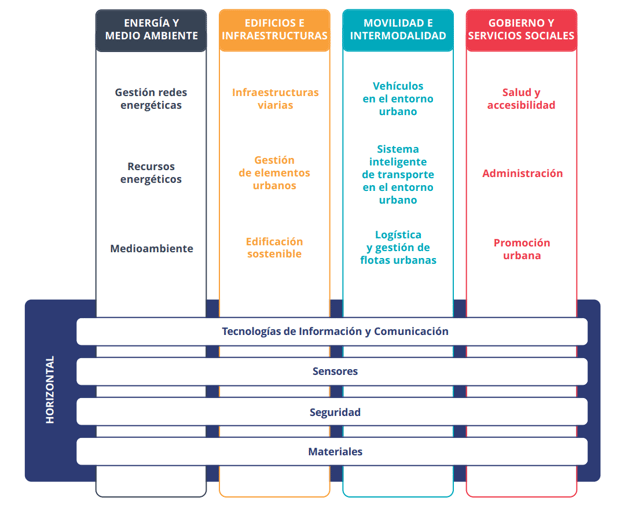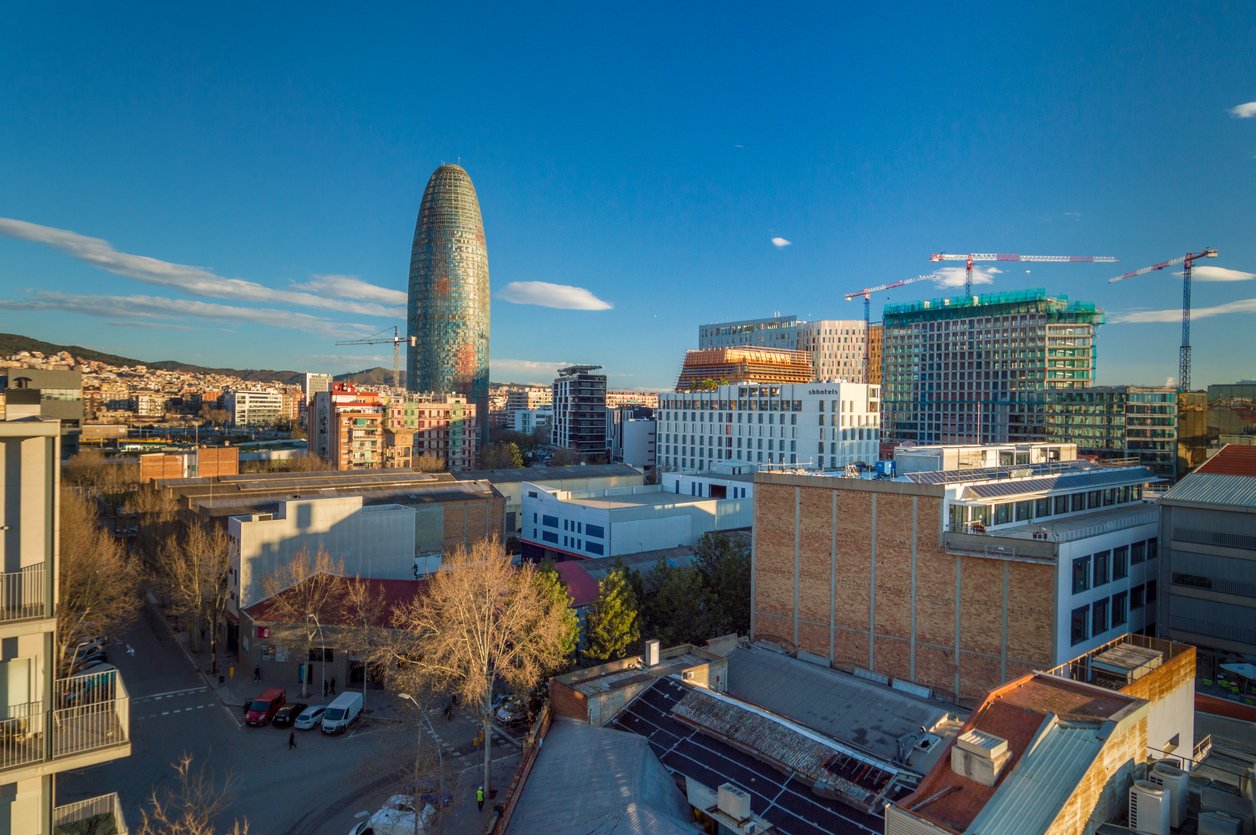In the quest to improve people's quality of life and optimise urban resources, the concept of the Smart City has arisen. These cities, through the incorporation of technology into their development, create more sustainable, efficient urban environments that are more focused on the needs of their inhabitants.
What is a Smart City?
A Smart City seeks to address sustainability issues in today's cities by adopting innovative measures in the management of energy, transport, buildings and other public services, as well as reducing CO2 emissions.
The use of Information and Communication Technologies (ICT) is a key feature of smart cities. The incorporation of ICT into urban planning aims to improve the efficiency of processes, the use of resources, and the quality of life of its users. In this way, sustainable development is promoted in all areas: economic, social, and environmental.

Requirements to become a smart city
The Smart Cities Interplatform Working Group (GICI) is a joint working group between the main Spanish technology platforms that was created in 2012 with the aim of developing the Smart City concept in depth.
This group proposes a smart city model that allows organizing all technological aspects related to cities. The aim of the model is to quantify and specify the parameters of a smart city, structured in 4 thematic or vertical areas that are affected by technology, as we can see in the following diagram:

Smart city model. Source: 2030 Vision Document of the GICI
The first step in talking about smart cities is to establish a coherent and standardised set of indicators to be able to monitor and evaluate the progress of cities in terms of technology over the years.
Various organisations are developing these indicators, both at the international level (ISO, OECD, UN, etc.) and at the national level (AENOR, Observatory of Sustainability in Spain, etc.). Just as technology evolves at a dizzying pace, so too are Smart City indicators likely to evolve to avoid obsolescence.
In the case of AENOR, the AEN/CTN 178 "Smart Cities" standard aims to facilitate the implementation of technological infrastructures that enable the development of a new urban services management model based on efficiency, sustainability and resilience. In its latest progress report, it states that the standard is currently under development, but also provides guidance on the categories around which indicators are defined.
Finally, the ISO 37122:2019 Sustainable cities and communities - Indicators for smart cities defines these indicators in an updated form, grouped into different sectors: economy, education, energy, environment, health, water, security, etc.
Key Concepts of Smart Cities
Some relevant concepts that help us understand how smart cities function and develop are:
Smart Grids
Smart Grids are electricity distribution systems that use advanced technology to improve the efficiency, reliability, security and sustainability of the electricity grid. These networks incorporate ICT to collect, analyse, and act on real-time data, allowing for more efficient and optimized electricity supply management. The connection to renewable energy sources and the integration of sustainable mobility are also examples of functions of Smart Grids.
Smart Buildings
Smart buildings make use of ICTs to increase their energy and water efficiency, which has an impact on minimising operational carbon emissions. The integration of technology is essential to ensure consumption control and its optimization.
A good example of the application of ICT in construction is Building Management Systems (BMS), which incorporate information received from: smart energy meters, lighting sensors, water leakage detectors, and other smart objects.

Smart electric meters
Interoperability
In a smart urban environment, where different technologies and platforms operate simultaneously, they need to be able to exchange data and use joint information. Ensuring this interoperability between products requires that the related technologies in smart cities be governed by a common standard.
Ensuring interoperability expands the range of products for users, and manufacturers can take advantage of the economies of scale of a larger market. Moreover, the standardization of communication protocols and data formats not only facilitates scalability but also promotes sustainable growth for smart cities.
Smart City Management Platform
The existence of a Management Platform in a smart city is crucial, as it is responsible for ensuring the optimal and efficient functioning of the services it offers. According to a study carried out by the National Observatory of Technology and Society, a management platform should pursue these main objectives:
- Collect information from the city, citizens, and businesses, respecting applicable privacy requirements.
- Distribute the information for processing by those responsible for the different services.
- Conduct analysis of the information following the defined criteria.
- Make decisions and return the refined information to the systems responsible for executing specific actions.
Examples of platforms include:
- Thinking City Platform: developed by Telefónica, it is based on FIWARE, a standard promoted by the EU. It allows integrating, processing, and distributing multiple sources and streams of information from multiple services, being able to track their status in real-time through dashboards.
- Wonderware Intelligence Platform: developed by Schneider, it is a platform that automates the calculation, contextualisation and storage of KPIs. Allows operations managers to improve their teams' performance through the visualization and analysis of critical information.
- VLCi Platform: this is the platform that manages and compiles data from sensors and information systems of the different services of Valencia City Council, carrying out statistical and predictive analysis. In the following section we develop Valencia in depth as an example of a Smart City.
Smart Cities in Spain: Case Studies
In recent decades, several cities in Spain have developed projects to promote an urban transformation that prioritises innovation and sustainability as fundamental pillars. The Spanish Network of Smart Cities (RECI), made up of more than 140 municipalities, acts as a link between them.
Another way to get an overview of the performance of smart cities is the IESE Cities in Motion Index, also known as ICIM. Annually, the weighted ranking of smart cities worldwide is published.
The index model proposes a set of steps that include diagnosing the situation, developing a strategy, and its subsequent implementation. The first step to making a good diagnosis is to analyse the situation of the key dimensions, so the index includes a total of 114 indicators that reflect both objective and subjective data, offering a broad view of each city.
In its latest index published in 2022, 183 cities around the world have been studied and weighted, 10 of which are Spanish. Madrid occupies the 27th position in its world ranking, behind capitals such as Vienna, Berlin or Stockholm, while Barcelona occupies the 31st position.
22@ Urban Lab, Barcelona
One of the most outstanding Smart Cities projects in Spain is the 22@ Urban Lab in Barcelona. This initiative has transformed the former industrial area of the Poblenou district into an urban zone with a strong component of innovation and creativity.

District 22@ in Barcelona
The aim of the project is to consolidate Barcelona's position as an innovative and dynamic city, using it as an urban laboratory for companies that want to carry out tests in any of the areas covered by the Smart City.
Some of the measures implemented in the 22@ district are:
- Implementation of a sustainable mobility project through the creation of a charging infrastructure for electric vehicles.
- Establishment of traffic control cameras that enable real-time monitoring of vehicle flow.
- Incorporation of telematic reading systems for instant monitoring of electricity, water, and gas consumption in more than 150 homes.
- Outdoor lighting points with LED technology, equipped with presence, vibration, temperature sensors, GSM antennas, and webcam.
SmartCity València
Valencia, capital of the Valencian Community, has positioned itself as a benchmark city in the implementation of projects to become a Smart City. In the IESE index mentioned above, Valencia stands out as the third best-scoring Spanish city, surpassed only by Madrid and Barcelona.
Among the most notable initiatives carried out in Valencia, we find:
 Wifi4EU: Valencia is the first major city to join the European network of free, high-speed public internet. This digitalization strategy aims to address the digital divide in the different neighbourhoods of the city.
Wifi4EU: Valencia is the first major city to join the European network of free, high-speed public internet. This digitalization strategy aims to address the digital divide in the different neighbourhoods of the city.- Smart containers: A total of 135 glass containers and 127 light packaging containers are equipped with sensors that provide information on the available capacity level in each unit, as well as the status of their battery and temperature.
- Geoportal: Through this tool, it is possible to locate bicycles available for shared use, know the real-time traffic status, as well as obtain information about services such as libraries and museums, among others.
- Environmental sensors on buses: 44 Valencia city buses are equipped with sensors that monitor air quality, temperature, humidity and noise levels in the city
Facade of the City of Arts and Sciences, Valencia
All these technological initiatives are managed from VLCi's own platform, which complies with the European FIWARE standard. This platform centralizes and processes information from the Valencia City Council systems and the smart devices deployed throughout the city.
In conclusion, smart cities represent an innovative and promising solution in the context of increasing global urbanisation. However, it is worth noting that its development presents new challenges, such as cybersecurity or data privacy. To reach the full potential of these smart cities, it is crucial to promote collaboration between public and private entities, as well as the development of networks and associations.


